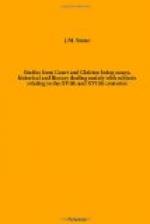“I know a merchant man,” wrote Bale, Bishop of Ossory as quoted by Leland, “which at this time shall be nameless, that bought the contents of two noble libraries for forty shillings apiece. A shame it is to be spoken. This stuff hath he occupied, instead of grey paper, by the space of more than these ten years, and yet he hath store enough for as many years to come. A prodigious example is this, and to be abhorred of all men which love their nation as they should do. Yea, what may bring our realm to more shame and rebuke than to have it noised abroad that we are despisers of learning? I judge this to be true, and utter it with heaviness, that neither the Britons under the Romans, nor yet the English people under the Danes and Normans had ever such damage of their learned monuments as we have seen in our time. Our posterity may well curse this wicked fact of our age, this unreasonable spoil of England’s most noble antiquities.”
Centuries had been spent in collecting that which a few short months had sufficed to scatter abroad, and Bishop Tanner also mentions with sorrow the loss of a great number of excellent books, to the unspeakable detriment of the learned world.
For a time, this havoc of the monastic libraries went on unchecked, but during the reign of Elizabeth a reaction set in, and there arose a little knot of men who had the good sense to recognise the value of these memorials of the past, and to treasure up what still remained; and the next generation produced such men as Thomas Bodley, and Robert Cotton. These were followed by others of kindred tastes, to whom more golden opportunities of acquiring valuable treasure-trove were afforded.
We shall confine ourselves here to the most illustrious of these collectors, Sir Robert Cotton, whose library now forms the basis of the national collection in the British Museum.
The era of English libraries began with Matthew Parker’s gift to Corpus Christi College, Cambridge, a collection of books which has preserved from destruction more materials relating to the civil and ecclesiastical history of this country than had ever before been gathered into one library. Fuller styled this munificent bequest “the Sun of English antiquity, before it was eclipsed by that of Sir Robert Cotton.”
Sir Thomas Bodley was one of the first men in Europe to conceive the notion of a great public library, and the rich collection of books which he made at Oxford on the ruins of Duke Humphrey’s library, and which he bequeathed to the University, is not merely of European, but of world-wide celebrity. Living as he did at Oxford in a learned atmosphere, he naturally turned his chief attention to Latin manuscripts, while Cotton made English history his special study, and was ever on the alert for material to throw fresh light upon its annals. Hence the numerous Anglo-Saxon MSS. in his library, and the splendid collection of State papers, relating to England, Scotland, and France, contained in the dress marked Caligula, and in many other places.




